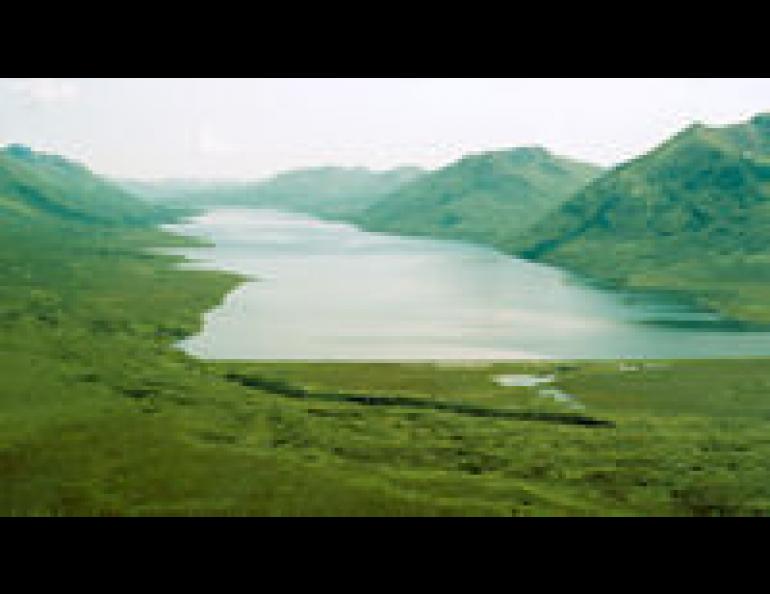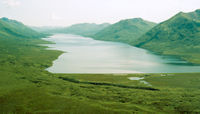
Ancient Salmon Tell Tales of Change in Alaska
Traces of salmon from 2,000 years ago are telling researchers a lot about Alaska's past.
The salmon lived on Kodiak Island, and Bruce Finney is one of the scientists who visits there to pull up plugs of ancient Alaska from lakes. Finney is an associate professor at the University of Alaska Fairbanks' Institute of Marine Science. He is co-author of a recent paper in the journal Nature, "Fisheries productivity in the northeastern Pacific Ocean over the past 2,200 years."
The abundance of fish during the last 22 centuries and beyond is held in the sediment at the bottom of lakes. A few years ago, Finney devised a method to estimate ancient salmon runs by measuring a specific nitrogen level in this muck. For the latest study, he teamed with graduate student Irene Gregory-Eaves and professor John Smol of Queens University in Ontario. Together, they further validated Finney's method and came up with records of salmon booms and busts that lasted centuries and were out-of-phase with fish numbers in the Pacific Northwest. They also found correlations with salmon availability and human settlement of Alaska.
Finney uses nitrogen-15 as an indicator of salmon past. Salmon collect nitrogen-15 in their bodies, and when they die and decompose, they release the nutrient into the water. Plankton ingest the nitrogen-15 and leave behind a history of salmon abundance when they die and sink to the lake bottom. By dating layers of sediment using volcanic ash layers and other methods, Finney and his colleagues can determine how abundant salmon were at different periods in history. Complementing this technique is the work of John Smol, who studies diatoms, single-celled algae with cell walls made of glass. Smol knows what species of diatoms prefer an environment rich in salmon-derived nutrients; he was able to complement what Finney had to say about salmon during the past 2,200 years.
During the latest study, the researchers pushed off from shore in boats and pulled cores from three lakes on Kodiak Island. Two of the lakes, Karluk and Akalura, have been nurseries for oceangoing red salmon since the lakes were formed. A third lake, Frazer Lake, has a waterfall that prevented red salmon from living there until the installation of a fish ladder in the 1960s. Finney, Gregory-Eaves, and Smol used Fraser Lake as a control lake in their study.
The researchers found that salmon booms and busts lasted hundreds of years, not just the decades they last today. One of the longest-running high salmon runs in Alaska began about 800 years ago and lasted until about the 1880s, which coincides with the start of commercial fishing.
Commercial fisherman catch 50-to-90 percent of the salmon that would return to lakes, but the study also showed low salmon runs in the past that lasted hundreds of years without human influence, Finney said. Around the birth of Christ and 800 years afterward, few salmon were returning to the lakes compared to the millions returning today.
Records of sardine and anchovy abundance from cores containing ancient fish scales taken off the California coast near Santa Barbara show that those fish were thriving when Alaska fish were in low numbers, and vice versa. Other scientists have noted the same thing today-great Alaska salmon years, are bust years for Pacific Northwest fishermen.
The researchers also tied salmon abundance with archaeological artifacts found on Kodiak. A drastic increase in salmon from AD 800 to AD 1200 matches a population increase on the island and a shift toward the use of fishing gear among aboriginal people.
"There's clear evidence that people shifted from relying on marine mammals to salmon," Finney said.
In the future, Finney wants to return to the lakes to extract deeper cores that will allow the researchers to get a record of salmon runs since the last ice age. He's interested in seeing how salmon reacted to a period about 5,000-to-10,000 years ago, when summer temperatures may have been about 2-4 degrees C warmer than today. Looking at the warmer past in the sediment of Kodiak lakes may tell us something about our future.





